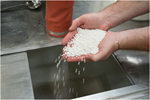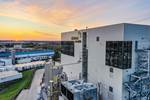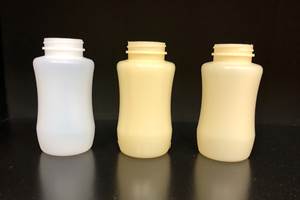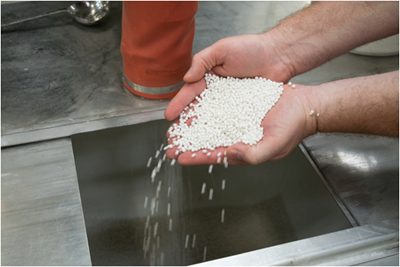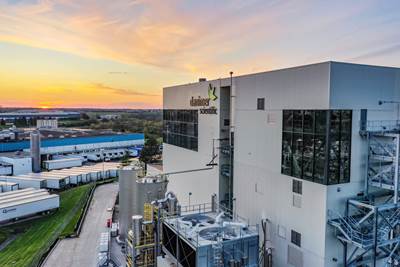Why Are They Blending Biopolymers?
A sit-down with bioplastic producer Danimer Scientific showed me there are more possible answers to that question than I had previously thought.
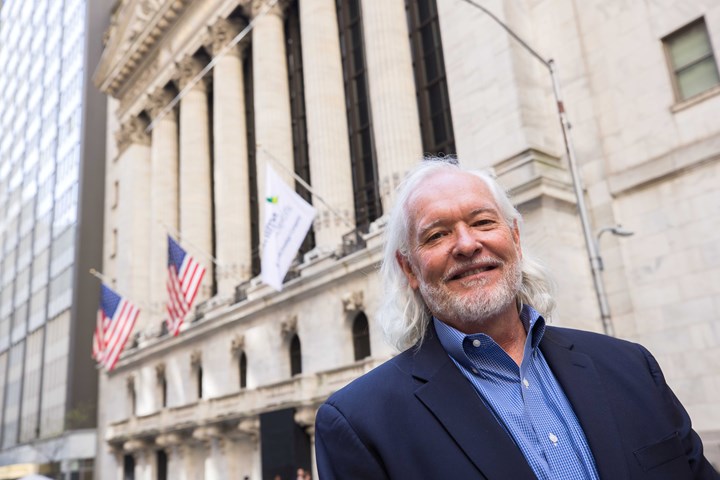
Danimer Scientific CEO and board chairman Stephen Croskrey in front of the New York Stock Exchange, where he rang the closing bell on April 17. He’s doubling Danimer’s capacity for Nodax PHA biopolymer. (Photo: Danimer Scientific)
When I want to learn more about the future of biopolymers, the first place I’d go is not normally the trading floor of the New York Stock Exchange (known affectionately to its denizens as NYSE). But that’s where I found myself last week, when I was invited to attend the ringing of the closing bell by Stephen Croskrey, chairman and CEO of Danimer Scientific, Inc. Danimer is a major producer of polyhydroxyalkanoate (PHA) bioplastics and a formulator of customized compounds based on polylactic acid (PLA) bioresin. Before the closing ceremony, I had the opportunity to interview Croskrey and Phil Van Trump, the company’s chief technology officer, on where they were heading with PHA and PLA.
Before getting into what they told me – much of which was unexpected – let’s be clear about terminology. When I use the term biopolymer, bioplastic or bioresin, I’m referring to materials that are produced by biological action – microbial fermentation of plant-derived carbohydrates. That is a small subset of all biobased or renewably sourced plastics, which typically start with a plant-derived feedstock but are mostly processed by industrial chemical technologies involving no living organisms (except the operating personnel).
I came to the Danimer conversation with a few preconceptions: 1) PHA today is too expensive to be attractive on its own for many applications. 2) PLA costs less and helps bring down the cost of blends with PHA. 3) Mechanical and thermal properties of PHA are superior to those of PLA, making PHA a handy tool for formulating “enhanced PLA” blends.
Sitting down in a quiet room away from the hubbub of the NYSE trading floor, I plunged into the conversation with the question that was foremost on my mind: “Is blending with PLA essential to the future of PHA?” I asked Mr. Croskrey. “Essential, no,” he answered. “But we see blends of the two as a way to stretch our PHA capacity to meet market demand.” That was my first surprise.
As Croskrey explained, the company today has what it calls “the world’s first commercial production facility for PHA” in Winchester, Ky., with nameplate annual capacity of 32.5 million lb of pure PHA. Croskrey said that translates roughly into 65 million lb of effective capacity for PHA/PLA blends. At Danimer’s headquarters in Bainbridge, Ga., work is underway on a plant capable of 65 million lb/yr nameplate capacity for pure PHA – or around double that for blends with PLA. Croskrey expects the new plant to be operating in late 2025.
So, the first thing I learned from this meeting was the strategic value to Danimer of PLA in blends with PHA. (As I write this, I’m tempted by an analogy to Hamburger Helper, though I’m not sure the Danimer folks would approve.)
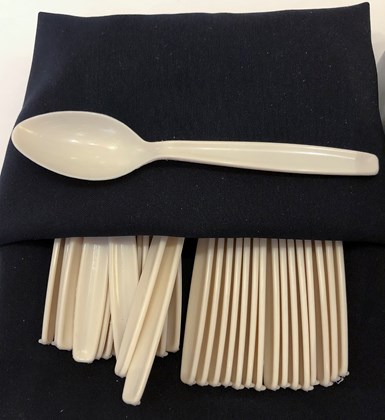
PHA biopolymer is frequently blended with PLA (as in these coffee spoons) to extend available supplies of PHA, enhance the biodegradability and compostability of PLA, improve PLA’s processing and performance properties, and reduce overall compound cost relative to pure PHA. (Photo: Matthew Naitove)
The second thing I learned is that I wasn’t wrong in thinking that blending with PLA lowers the cost relative to pure PHA – but that advantage may be short-lived. Danimer’s Nodax PHA currently sells for $2.50 to $3.00/lb in pure form. PLA costs substantially less. However, Croskrey said, when the new Georgia plant comes on line, economies of scale will eliminate economics as an incentive for blending PHA with PLA.
As for other incentives, the third thing I learned is that PHA does indeed enhance the properties of PLA in blends, but not necessarily in the way I imagined. Van Trump confirmed my understanding that PHA can add heat-distortion resistance and impact strength to PLA, and also improves processability by reducing the overall melt temperature, which decreases sensitivity to degradation during melt processing.
However, when I asked Croskrey about how PHA improves the performance of PLA, his thoughts went first to improving the environmental acceptability of PLA. As he explained, PLA by itself is industrially compostable, while PHA is home compostable – a less demanding requirement – as well as marine degradable, the highest standard of degradability. PHA can make PLA blends home compostable as well. That result, Croskrey stated, is important to customers’ corporate sustainability goals and ESG (environmental, social and governance) goals.
The end result of this conversation was to substantially revise my initial preconceptions: 1) PLA is important to Danimer as a blending agent to stretch its PHA capacity to meet demand. 2) Blending with PLA to reduce the cost of PHA is a temporary consideration, which should vanish when larger-scale production comes on line in a couple of years. 3) Adding PHA to PLA for the sake of improved processability or mechanical and thermal properties may be less important to some end users and brand owners than PHA’s ability to enhance PLA’s degradability and compostability.
We ended the conversation on an additional note: “Exploration of the PHA family has a long way to go,” said Croskrey. There are several different PHA varieties on the market today, and Danimer acquired an additional variant when it purchased Novomer in 2021. That company’s Rinnovo P3HP (poly 3-hydroxyproprionate) PHA is biobased but is produced by catalytic conversion rather than biological fermentation. Poly3HP has less heat resistance than Nodax PHA but is much cheaper to produce – in both capital and operating costs – and has the notable advantage of much better oxygen and moisture barrier than PLA or other PHAs – “similar to Saran PVDC,” according to Van Trump. It also has very high biodegradability similar to Nodax PHA.
Add that to the range of other biodegradable and at least partly biobased resins in Danimer’s arsenal of blending agents for PHA – such as PBS (polybutylene succinate) – and Danimer has a wide-open field for bioresin formulating exploration.
Related Content
How to Extrusion Blow Mold PHA/PLA Blends
You need to pay attention to the inherent characteristics of biopolymers PHA/PLA materials when setting process parameters to realize better and more consistent outcomes.
Read MoreICIS Launches: Ask ICIS Generative AI Commodities Assistant
Said to be the first of its kind, this AI assistant will enhance access to ICIS’ intelligence and insights for the energy and chemical markets.
Read MorePHA Compound Molded into “World’s First” Biodegradable Bottle Closures
Beyond Plastic and partners have created a certified biodegradable PHA compound that can be injection molded into 38-mm closures in a sub 6-second cycle from a multicavity hot runner tool.
Read MoreHow to Optimize Injection Molding of PHA and PHA/PLA Blends
Here are processing guidelines aimed at both getting the PHA resin into the process without degrading it, and reducing residence time at melt temperatures.
Read MoreRead Next
PHA/PLA Blends for Coffee Pods Meet EU Compostability Specs
Danimer Scientific and TotalEnergies Corbion collaborate on biopolymer blends that meet proposed EU compostability requirements for coffee pods and other plastic packaging.
Read MoreDanimer Scientific to Acquire Biodegradable Polymer Developer Novomer
Novomer’s technology expected to boost Danimer’s Nodax PHA resin portfolio and lower costs.
Read MoreDanimer Scientific Boosts Capacity of Nodax PHA Bioplastic
Optimized processes and equipment will enable output of 20 million lbs of finished product annually to meet global demand for biodegradable polyhydroxyalkanoate (PHA).
Read More


